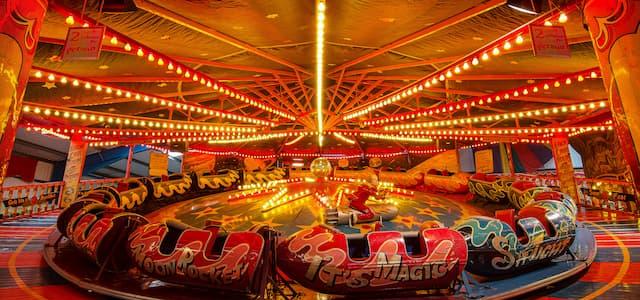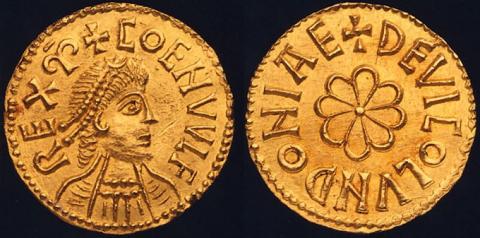
Unique Anglo-Saxon gold coin acquired by the British Museum
The British Museum is delighted to announce that it has acquired a rare and important Anglo-Saxon gold coin depicting Coenwulf King of Mercia (796-821).

The Museum is extremely grateful for the generous support of the National Heritage Memorial Fund (NHMF) and the National Art Collections Fund (the Art Fund) among others, in making this purchase possible. The Museum successfully managed to raise the amount required to reach the export license figure, making it the most expensive British coin ever purchased.
The coin is tremendously important as a new source of information on Anglo-Saxon kingship in the early ninth century, a period which is little documented in English history. One of only eight known gold coins of the mid to late Saxon period, of which the Museum now owns seven, this unique coin is probably the earliest example of a gold coin in the name of an English ruler intended as part of a circulating currency. Coenwulf’s kingdom of Mercia stretched from the Thames in the south to the Humber in the north, and the Welsh border in the west. Through conquest, he also ruled the kingdoms of East Anglia and Kent. His combined kingdom made him the most powerful single ruler in Britain at that time.
The coin is in far better condition than the other known examples. Beautifully struck and exceptionally well-preserved, it offers an insight into both the expression of royal power and monetary developments in England during this period. It provides new details about the status of London during Coenwulf's reign, and about his political and economic relationship with continental Europe and his famous contemporary, Charlemagne. It was found by a metal detectorist near Bedford in 2001.
The coin will go on display in the Museum in the HSBC Money gallery from 9th February, alongside other Anglo-Saxon gold coins in the collection and related material.
Stephen Johnson, Head of the National Heritage Memorial Fund said: “The Coenwulf Coin is exactly the sort of thing that the NHMF was set up save. Today's announcement sees this precious and valuable reminder of our Anglo-Saxon past joining the outstanding collections of the British Museum, but also the world-class collection of objects and places saved by NHMF for the people of Britain, to encapsulate the rich story of Britain."
David Barrie, Director, Art Fund, adds: 'We were really impressed by this exceptionally rare and beautiful coin. The Anglo-Saxon world can seem very remote but an object like this helps bring it to life. We are delighted to have helped add such a precious coin to the national collection held at the British Museum - which is just where it belongs."
Gareth Williams, Anglo-Saxon coin curator, British Museum commented: “The Coenwulf gold coin is tremendously significant as a new source of information on Anglo-Saxon kingship in the early ninth century. We are delighted to have acquired this piece for the national collection and would like to thank the NHMF, the Art Fund, the Goldsmiths’ Company, and the other donors for their generous contribution”
Notes to editors
The Coenwulf Coin
The coin was purchased by the Museum for £357,832, a record figure for a British coin. The NHMF provided £225,000; the Art Fund £60,000; British Museum Friends £10,000; and the Goldsmiths’ Company £5,000. Individual donations provided over £3,000, with the remainder paid for by the British Museum itself.
The Museum is making arrangements for the coin to be displayed at the Bedford Museum in 2007, thus enabling it to be seen close to its findspot. This is part of a wider plan for the coin to be exhibited at a number of museums across Coenwulf’s former kingdoms as part of Partnership UK, the Museum’s national touring programme. The tour will start at Norwich Castle Museum.
The weight of the coin suggests it was designed to represent the sum of a ‘mancus’, a word which appears to have represented both a nominal weight of c.4.25g and also the value of thirty silver pennies.
The coin also provides new information about the status of London during Coenwulf's reign, in addition to carrying his name and title on the obverse, the coin contains the intriguing inscription DE VICO LVNDONIAE(from the trading place of London) on the reverse. This has parallels with a gold coin of Coenwulf’s contemporary Charlemagne, with the description VICO DORESTATIS. This suggests that Coenwulf, who was the overlord of much of southern England as well as king of Mercia, was playing one-upmanship games with the most powerful ruler in Europe. In addition, London is described as a ‘vicus’ rather than a ‘civitas’, implying that in the context of this coin, London was seen as a trading centre rather than a centre of royal authority.
The National Art Collections Fund
The National Art Collections Fund (Art Fund) is the UK’s leading art charity. It has 80,000 members. Since its foundation in 1903, the Art Fund has helped UK public collections acquire over 850,000 works of art. In 2004 the Art Fund offered £4.3million to museums and galleries and distributed 11 gifts and bequests. The Art Fund is independent of government and raises money from membership subscriptions, donations and legacies. The Art Fund has led successful campaigns to save for the nation masterpieces such as Velázquez’s ‘Rokeby Venus’, the Leonardo Cartoon and the Macclesfield Psalter.
Further information
Hannah Boulton, phone: 020 7323 8522, email: hboulton@thebritishmuseum.ac.uk
Joe Edwards, phone: 020 7323 8583, email: jedwards@thebritishmuseum.ac.uk

